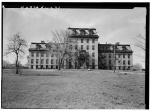Difference between revisions of "Portal:Featured Article Of The Week"
M-Explorer (talk | contribs) |
M-Explorer (talk | contribs) |
||
| Line 1: | Line 1: | ||
{{FAformat | {{FAformat | ||
| − | |Title= | + | |Title= Dexter State Hospital |
| − | |Image= | + | |Image= Dexter.jpg |
|Width= 150px | |Width= 150px | ||
| − | |Body= The | + | |Body= The Dexter Asylum served as an institution for the care of the poor, aged and mentally ill of Providence from 1828 to 1957. The Asylum began through a bequest in the will of Ebenezer Knight Dexter (1773-1824), a wealthy citizen who had served on a town committee for poor relief. Dexter's gift to the town, though much needed at the time, later was seen as an anachronism--a walled and isolated "poor farm" in the midst of Providence's residential east side. Beginning in the 1920's, city officials, developers and assorted heirs made several attempts to change the conditions of the will, and in 1957, they finally succeeded. The Dexter Asylum property was sold to Brown University. |
| − | + | Ebenezer Dexter's will of 1824 left a property known as Neck Farm to Providence to be used for "the accommodation and support of the poor of said town... and for no other use or purpose whatever." The bulk of his estate was left to the city (then town) for the construction and upkeep of the asylum and the care of the poor. Dexter's will further called for the town to erect a stone wall around the property, forbade the town to sell Neck Farm, and specified that a town meeting of no less than "forty freemen" should be required for any action concerning the property. | |
| + | |||
| + | Before Dexter's bequest, Providence had no institution for the care of the poor. Those unable to support themselves due to age or illness were cared for at town expense in private homes by caretakers who bid for the job. A committee formed soon after Dexter's death to oversee the donation, and town meetings from 1824 until the original building's completion in 1828 discussed the construction, operation and rules of the asylum. [[Dexter State Hospital|Click here for more...]] | ||
}} | }} | ||
Revision as of 07:18, 26 November 2017
Featured Article Of The Week
Dexter State Hospital
The Dexter Asylum served as an institution for the care of the poor, aged and mentally ill of Providence from 1828 to 1957. The Asylum began through a bequest in the will of Ebenezer Knight Dexter (1773-1824), a wealthy citizen who had served on a town committee for poor relief. Dexter's gift to the town, though much needed at the time, later was seen as an anachronism--a walled and isolated "poor farm" in the midst of Providence's residential east side. Beginning in the 1920's, city officials, developers and assorted heirs made several attempts to change the conditions of the will, and in 1957, they finally succeeded. The Dexter Asylum property was sold to Brown University.
Ebenezer Dexter's will of 1824 left a property known as Neck Farm to Providence to be used for "the accommodation and support of the poor of said town... and for no other use or purpose whatever." The bulk of his estate was left to the city (then town) for the construction and upkeep of the asylum and the care of the poor. Dexter's will further called for the town to erect a stone wall around the property, forbade the town to sell Neck Farm, and specified that a town meeting of no less than "forty freemen" should be required for any action concerning the property.
Before Dexter's bequest, Providence had no institution for the care of the poor. Those unable to support themselves due to age or illness were cared for at town expense in private homes by caretakers who bid for the job. A committee formed soon after Dexter's death to oversee the donation, and town meetings from 1824 until the original building's completion in 1828 discussed the construction, operation and rules of the asylum. Click here for more...
